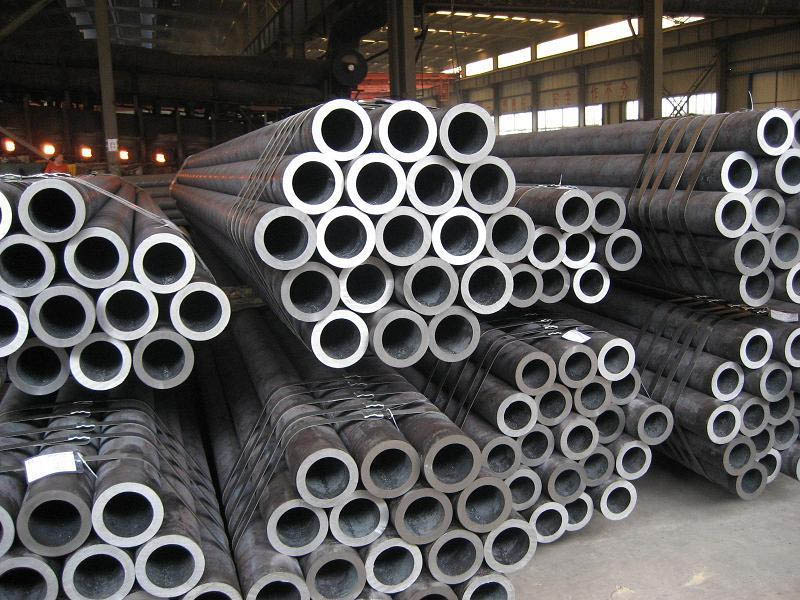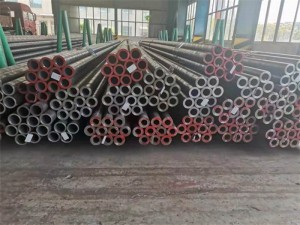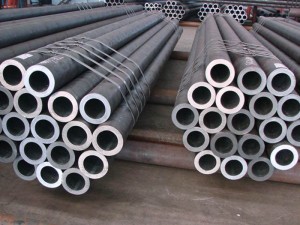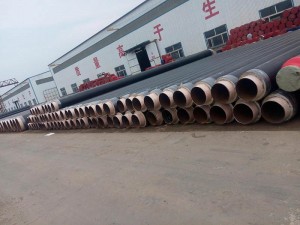A335 P12 A369 FP12 13CRMO44 A213 T12 alloy steel pipe
40Cr steel pipe is a kind of round steel with hollow section and no joints around. It is made of solid pipe blank through perforation, and then made of hot rolling, cold rolling or cold drawing. Compared with round steel and other solid steel, when the bending and torsional strength is the same, the weight of steel pipe is lighter, which is a kind of economic section steel.

According to GB / T 3077-2008: chemical composition (mass fraction,%) C 0.37 ~ 0.44, Si 0.17 ~ 0.37, Mn 0.50 ~ 0.80, cr0.80 ~ 1.10, Ni ≤ 0.30【 Mechanical properties]
Sample blank size (mm): 25
Heating temperature of the first quenching (℃): 850; Coolant: Oil
Second quenching heating temperature (℃):-
Tempering heating temperature (℃): 520; Coolant: water, oil
Tensile strength (σ b/MPa): ≧980
Yield point (σ s/MPa): ≧785
Elongation after fracture(δ 5/%): ≧9
Reduction of area(ψ/%): ≧45
Impact absorption energy (aku2 / J): ≥ 47
Brinell hardness (hbs100 / 3000) (annealed or high temperature tempered): ≤ 207
The standard steel grades of GB in China are 40Cr, DIN material No. 1.17035/1.7045, DIN 41Cr4 / 42gr4, en 18, BS 41Cr4, AFNOR 42c4, NF 38cr4 / 41Cr4, uni 41Cr4, NbN 42cr4, SS 2245 American AISI / SAE / ASTM Standard Steel No. 5140, Japanese JIS standard steel No. scr440 (H) / scr440, American AISI / SAE / ASTM Standard Steel No. 5140, international organization for Standardization ISO standard steel No. 41Cr4.
(approximate) ACM = 780 ℃
Temperature 850 ~ 870 ℃, hardness 179 ~ 229hbs.
The temperature is 740 ~ 760 ℃, the holding time is 4 ~ 6h, and then the temperature is cooled to ≤ 600 ℃ at the cooling rate of 5 ~ 10 ℃ / h.
Hardness before treatment ≤ 217hbs, hardness after softening ≤ 163hbs.
(670±10)℃ × 2H, temperature rise with the furnace, (710 ± 10) ℃ × 2H, cool down with the furnace, (670 ± 10) ℃ × 2H, temperature rise with the furnace, (710 ± 10) ℃ × 2H, then lower the temperature with the furnace, (670 ± 10) ℃ × 2H, temperature rise with the furnace, (710 ± 10) ℃ × 2H, cool down with the furnace for 3 cycles, and then cool down to 550 ℃ for air cooling. Hardness after treatment is 153hbs.
Quenching temperature 850 ℃± 10 ℃, oil cooling; Tempering temperature 520 ℃± 10 ℃, water, oil and air cooling.
Medium carbon modulated steel, cold heading die steel. The steel has moderate price and easy processing. After appropriate heat treatment, it can obtain certain toughness, plasticity and wear resistance. Normalizing can promote tissue spheroidization and improve the cutting performance of blanks with hardness less than 160hbs. Tempered at 550 ~ 570 ℃, the steel has the best comprehensive mechanical properties. The hardenability of this steel is higher than that of 45 steel. It is suitable for surface hardening treatment such as high frequency quenching and flame quenching.
After quenching and tempering, this steel is used to manufacture mechanical parts bearing medium load and medium speed, such as steering knuckle, rear half shaft of automobile, gear, shaft, worm, spline shaft, center sleeve, etc. on machine tool; After quenching and medium temperature tempering, it is used to manufacture parts bearing high load, impact and medium speed, such as gear, main shaft, oil pump rotor, sliding block, collar, etc; After quenching and low-temperature tempering, it is used to manufacture parts with heavy load, low impact, wear resistance and solid thickness less than 25mm on the section, such as worm, main shaft, shaft, collar, etc; After quenching and tempering and high-frequency surface quenching, it is used to manufacture parts with high surface hardness and wear resistance without great impact, such as gear, sleeve, shaft, main shaft, crankshaft, spindle, pin, connecting rod, screw, nut, inlet valve, etc. In addition, this steel is also suitable for manufacturing various transmission parts treated by carbonitriding, such as gears and shafts with large diameter and good low temperature toughness.
Annealed, hardness ≤ 207hbs. 40Cr elastic modulus: elastic modulus E (20 ℃) / MPA 200000 ~ 211700, shear modulus G (20 ℃) 80800
Quenching process of 40Cr
40Cr quenching, 850 ℃, oil cooling; Tempering 520 ℃, water cooling, oil cooling. The surface quenching hardness of 40Cr steel pipe is hrc52-60, and the flame quenching can reach hrc48-55.
40Cr nitriding treatment
40Cr belongs to nitrided steel, and its elements are conducive to nitriding. 40Cr can obtain higher surface hardness after nitriding treatment, and the highest hardness after nitriding treatment can reach hra72 ~ 78, i.e. hrc43 ~ 55. Nitriding workpiece process route: forging annealing rough machining quenching and tempering finish machining stress removal rough grinding nitriding finish grinding or grinding. Because the nitrided layer is thin and brittle, it is required to have a high-strength core structure, so it is necessary to carry out quenching and tempering heat treatment first to obtain tempered sorbite and improve the mechanical properties of the core and the quality of the nitrided layer. Soft nitriding is active nitriding, and gas nitriding is commonly used
40Cr welding
Before 40Cr welding, pay attention to preheating to prevent quench crack inside the weld due to matrix heat dissipation. It is best to normalize before welding.
Weldability of 40Cr: it is easy to segregate during crystallization and is sensitive to crystallization crack (a kind of thermal crack). It is easy to crack in the crater and concave part in the weld during welding. With high carbon content, it is easy to obtain hardened structure (martensite) which is very sensitive to cold cracks during rapid cooling. When the cooling rate of superheated zone is large, it is easy to form hard and brittle high carbon martensite and embrittle the superheated zone.
1. Welding is generally carried out in the annealed (normalized) state.
2. The welding method is not limited
3. The preheating temperature can be appropriately increased with large linear energy. Generally, the preheating temperature and interlayer temperature can be controlled between 250 ~ 300 ℃.
4. The welding material shall ensure that the composition of the deposited metal is basically the same as that of the base metal, such as j107-cr
5. Quenching and tempering heat treatment shall be carried out in time after welding. If it is difficult to carry out quenching and tempering treatment in time, intermediate annealing or holding at a temperature higher than preheating for a period of time can be carried out to eliminate diffused hydrogen and soften the structure. For products with complex structure and many welds, an intermediate annealing can be carried out after welding a certain number of welds








